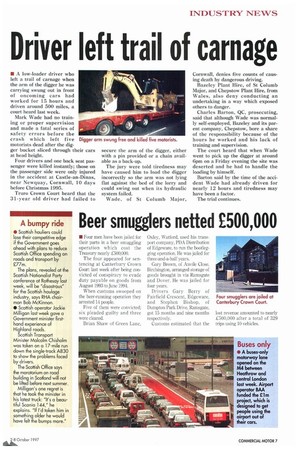Driver left trail of carnage
Page 9

If you've noticed an error in this article please click here to report it so we can fix it.
• A low-loader driver who left a trail of carnage when the arm of the digger he was carrying swung out in front of oncoming cars had worked for 15 hours and driven around 500 miles, a court heard last week.
Mark Wade had no training or proper supervision and made a fatal series of safety errors before the crash which left five motorists dead after the digger bucket sliced through their cars at head height.
Four drivers and one back seat passenger were killed instantly; those on the passenger side were only injured in the accident at Castle-an-Dinas, near Newquay, Cornwall, 10 days before Christmas 1995.
Truro Crown Court heard that the 31-year old driver had failed to secure the arm of the digger, either with a pin provided or a chain available as a back-up.
The jury were told tiredness may have caused him to load the digger incorrectly so the arm was not lying flat against the bed of the lorry and could swing out when its hydraulic system failed.
Wade, of St Columb Major, Cornwall, denies five counts of causing death by dangerous driving.
Bazeley Plant Hire, of St Columb Major, and Chepstow Plant Hire, from Wales, also deny conducting an undertaking in a way which exposed others to danger.
Charles Barton, QC, prosecuting, said that although Wade was normally self-employed, Bazeley and its parent company, Chepstow, bore a share of the responsibility because of the hours he worked and his lack of training and supervision.
The court heard that when Wade went to pick up the digger at around 6pm on a Friday evening the site was deserted and he had to handle the loading by himself.
Barton said by the time of the accident Wade had already driven for nearly 12 hours and tiredness may have been a factor.
The trial continues.








































































































